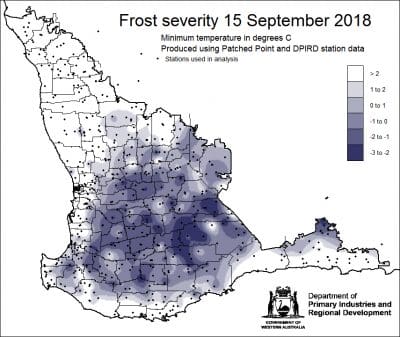WESTERN Australian grain growers have been encouraged to inspect crops for symptoms of frost damage, following a series of frost events over the past month, so they can make informed choices about how to frosted crops, including whether to cut for hay, to harvest.

Growers are being encouraged to inspect crops for signs of frost damage over coming weeks. Click to expand.
Minimum temperatures of between zero to -3 degrees Celsius have been recorded over parts of the central, eastern and southern wheatbelt over the past weekend and last month, while more localised events occurred mid-September.
Department of Primary Industries and Regional Development (DPIRD) research officer, Ben Biddulph, said it took five to 10 days for frost damage to become visible.
“It is recommended to check lower parts of the paddock for frost damage first, starting with light-textured soils, and assess a plant every 20 to 30 paces,” Dr Biddulph said.
“With crop variability across the wheatbelt, it is important for growers in affected areas to get into their crops and inspect plants for frost damage in the head, stem, flowers and developing grains.”
Dr Biddulph said wheat, barley and oat crops were most susceptible to frost damage after head emergence, although cereal crops could also be at risk during the early booting and grain-fill stages, while canola and pulses were most susceptible during early grain-fill.
“While there has been comment about the influence of the late season break on the frost damage from these events, it is difficult to estimate the true impact until harvest.”
Dr Biddulph said growers should wait until the full extent of frost damage was revealed, before making any hasty crop-management decisions.
“It is important for growers to wait and determine if crops are damaged by frost or not.
“Once this is clarified, they can make informed decisions about how best to manage that crop going forward.”
“Growers whose crops are affected by frost are encouraged to reinspect crops with their consultant and discuss management options to better understand the impact on their businesses.”
DPIRD has a range of resources available to assist growers to assess crops and evaluate subsequent management strategies and options on its 2018 Frost Trials and Seasonal Information webpage.
The Frost Identification Guide for Cereals, produced by DPIRD with support from the Grains Research and Development Corporation (GRDC), features photographs and explanations to help diagnose frost damage in wheat, barley and oats.
Fortnightly frost incidence maps are also available via the webpage.
“Frost can sometimes be difficult to diagnose,” Dr Biddulph said.
“These resources will assist growers and their consultants to make a timely, correct assessment of their crops.”
Minimum-temperature information from the department’s network of 175 weather stations across WA the State is available from DPIRD’s online weather pages.
The 2018 Frost Trials and Seasonal Information webpage also includes a link to management options for frosted crops.
The department has several GRDC-invested frost-research projects under way to improve understanding of how frost affects grains crops, to help WA growers reduce the impact of frost on crops.
These will be outlined at DPIRD’s Dale Frost and Canola field day, near Beverley, on Thursday, 11 October.
Source: DPIRD

HAVE YOUR SAY